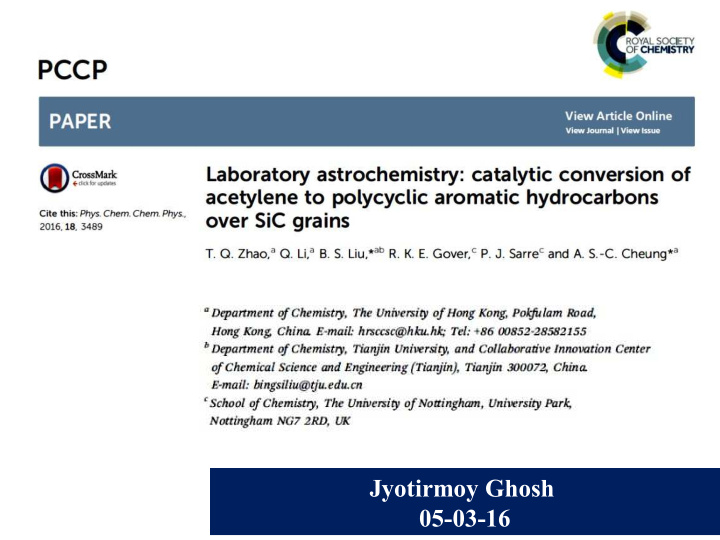



Jyotirmoy Ghosh 05-03-16
Overview of this work In this paper, they have studied the catalytic conversion of acetylene to polycyclic aromatic hydrocarbons (PAHs) on a solid SiC grain surface. PAHs play an important role in astrochemistry, which is an abundant molecule in carbon-rich circumstellar envelopes (CSEs) and they are the key molecules to understand the prebiotic roots of life. Gas-phase PAHs and intermediates were detected in-situ using time-of flight (TOF) mass spectrometry, and their formation was confirmed using GC-MS in a separate experiment by flowing acetylene gas through a fixed-bed reactor. For understanding the formation of PAHs in astrophysical environments, they have proposed a mechanism, where activation of acetylene correlated closely with the dangling bonds on the SiC surface which interact with and break the C–C π bond. 2
Background of this work 3 Nat. Commun., 2014, 5, 3054.
Experimental Pressure: Source chamber (3*10 -6 Torr) Ionization chamber (2*10 -6 Torr) 4
Experimental To study the catalytic formation of polycyclic aromatic hydrocarbons (PAHs) on a solid SiC grain surface from acytelene, here they have done two types of experiments- 1. Time-of flight (TOF) mass spectrometry 2. Gas chromatography- mass spectrometry (GC-MS) . Acetylene conversion reactions for forming PAHs over β-SiC or α-SiC were investigated in the temperature range of 400–750 °C . About 100 mg of β-SiC or α-SiC catalyst was placed inside the quartz tube reactor. . After that, the reagent gas (acetylene) was sent in pulsed mode to the reactor at a repetition rate of 10 Hz and with a pulse duration of 250–300 µs. . The products were ionized by an ArF excimer laser (193 nm) to generate molecular ions, which were accelerated by high voltage and travelled through the standard TOF field-free region. . The signals recorded by the multi-channel plate (MCP) detector. 5
Results and discussion 6
GC-MS Experiment In this separate experiment they used a continuous flow of acetylene gas at atmospheric pressure over the SiC catalyst, products were analyzed using GC-MS. This experiment was done to investigate- The larger PAHs adsorbed onto the SiC surface because they noticed that the heavier PAHs formed (mass> 250) likely condense on the surface of the catalyst. The home-built TOF-MS has relatively low mass resolution (1 mass unit) compared to GC-MS (up to 0.05 mass unit) Here, acetylene gas was allowed to flow for 30 minutes, and the effluent gas after passing through the SiC catalyst was directed to go through a cold trap to condense volatile compounds. In addition, there were also PAHs deposited on the SiC surface. The DCM solution obtained from dissolving the deposits on the SiC surface and from the cold trap are named Solution A and Solution B , respectively. 7
Results and discussion 8
Results and discussion α-SiC (Fig. 2a) exhibit an ordered morphology of a hexagonal crystal structure β-SiC (Fig. 2b) exhibit a zinc blende cubic structure LO branch: 11.3 and 12.7 µm or 884.96 & 787.4 cm -1 TO branch: 11.9 and 10.7 µm or 840.34 & 934.6 cm -1 9
Results and discussion The catalytic activity of β-SiC is significantly higher than α-SiC at lower temperature (≤ 600 °C), indicating that lower temperature is more favourable for β -SiC due to a structure of dispersive multicrystallites (Fig. 2b). 10
Proposed mechanism The dangling bonds on the SiC surface are potential active sites for chemisorption and activation. A silicon dangling bond, referred to as a silicon radical, has a single unpaired electron. The initial benzene ring formation is the rate-determining step for the PAH formation. 11
Proposed mechanism (152) (78) After the formation of the first aromatic ring (benzene), larger PAHs are formed following various routes according to the H-abstraction/C 2 H 2 addition (HACA) mechanism. Following the formation of benzene, the first mass number sequence of 24 appears at (m = 78, 102, 126,150) as a consequence of acetylene addition. The second sequence with a mass interval of 50 is observed at m = 128, 178, and 228 based on the addition of diacetylene. 12
Proposed mechanism 13
Results and discussion The PAH signals formed from acetylene over SiC were markedly higher than those from propyne and 2-butyne due to the fact that the C≡C triple bond connected to hydrogen is more likely to attack the dangling bonds on β-SiC(001). 14
Conclusions Understanding the catalytic conversion of acetylene to PAHs in carbon-rich circumstellar envelopes which has astrophysical relevance. They have proposed the mechanism for the catalytic conversion of acetylene to PAHs. Future aspect We have provision of depositing Si metal by using metal evaporator, installed in our instrument. Subsequently, we can study the catalytic action by Si on various molecular solids which have interstellar relevance. Ru@Si-CO Thank you 15
Recommend
More recommend